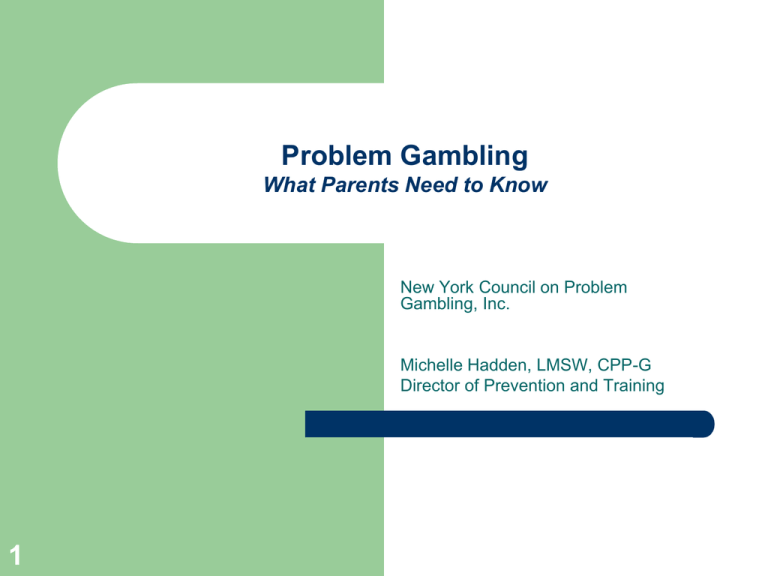
Problem Gambling
What Parents Need to Know
New York Council on Problem
Gambling, Inc.
Michelle Hadden, LMSW, CPP-G
Director of Prevention and Training
1
Gambling is a high risk behavior…
Particularly for
adolescents.
2
Why is youth gambling a problem
now?
3
Societal influences have normalized gambling
Parents, family members, schools, and the
community are not aware of the risks of youth
gambling
Today’s youth are the first generation to have
legal gambling throughout their lifetime
The media is bombarding youth with progambling messages
Five Types of Gamblers
4
Social Gambler
Problem Gambler
Pathological (Compulsive) Gambler
Organized Crime Gambler
Professional Gambler
Adolescents are actually more likely to
become pathological gamblers than
adults. (Gupta and Derevensky, 2000)
5
Impulsivity
Developmental nature
Susceptibility to peer influence
Emerging egos
The attraction of winning
Their belief that nothing negative can happen to them
Their lack of understanding that there can be a
downside to gambling
Adolescent Brain Development
6
Adolescence is a period of profound brain
maturation.
It was once believed that brain development
was complete during childhood.
The maturation process is not complete until
about age 24.
Does normal brain development
contribute to adolescent
susceptibility to gambling?
INDIRECT SUPPORT:
1. Greater risk taking (particularly in groups)
2. Greater propensity toward low effort-high
excitement activities
3. Lower capacity for good judgment and
weighing consequences
4. Greater sensitivity to novel stimuli
7
Types of Gambling in New York
State
Lottery
Horse Racing at Race
Tracks and OTB
Casinos
Floating Casinos (Cruises
to Nowhere)
Stock or Commodities
Market, Day Trading
8
Cards for Money, Dice,
and slots not at a Casino
Games of Skill for Money
Sports Betting
Office Pools, Raffles
Dog or Cock Fighting
Pull Tabs
Bingo
Internet Gambling
Forms of Gambling Presenting the
Greatest Risk to NY Adolescents
Card
State sponsored lottery games
Games of skill
Sports betting
Dice
(OASAS School Survey 2006)
9
Adolescent Gambling Statistics
National (1999)
(National Adolescent Review)
10
New York State
(1998)
New York State
(2006)
(Gambling and Problem Gambling Among
Adolescents in New York)
(OASAS School Survey)
1.5% of teens age 162.4% of teens are
17 can be classified as
currently suffering
“problem or pathological
gamblers
10% of students have
experienced problem
gambling in the past
year
2% can be classified as
“at-risk”
14% total are at risk for
developing a problem
20% either at risk or
already experiencing
problems
30-40% of adolescents
report gambling with
their parents
44% of adolescents
who have gambled
started with parents or
other family members
37% of students do not
know how their parents
feel about gambling.
Other Statistics
11
(OASAS School Survey, 2006)
72% of students in grades 712 engaged in at least one
gambling activity in the past
year.
34% have gambled within the
past month and 12% have
gambled four or more times in
the past month.
Males were 4x more likely to
have experienced problem
gambling compared to
females.
Problem/ Pathological Gambling
and Chemical Dependency
Of those students in grades 7-12 who are in
need of chemical dependency treatment
services, 28% also experienced problem
gambling in the past year.
(OASAS School Survey, 2006)
12
Reports show students that
reported gambling were:
Over 50% more likely to drink alcohol
More than twice as likely to binge drink
More than three times as likely to use
marijuana
Three times as likely to use other illegal drugs
Almost three times as likely to get in trouble
with the police
Almost three times as likely to steal or shoplift
(Gambling and Problem Gambling Among Adolescents in New York, 1998)
13
Risk Factors Associated With
Problem Gambling by Domain
(Gupta and Derevensky, 2000)
14
Community
Family
School Individual/ Peer
Constitutional
Accessibility
Family history of
addiction, illegal
activity
Poor
impulse
control
Delinquency and
persistent problem
behaviors
Biochemical factors
Lack of
Community
Awareness
Lack of parental
knowledge
Peer influence
Gender
Social
Acceptance
Competitive
home
environment
Attitudes favorable to
problems gambling
Depression
Media; television
lottery ads
Family attitudes
and involvement
Early win; early onset
of gambling
experiences
Suicide attempts
Lack of parental
objection to
youth gambling
Poor coping skills
WARNING SIGNS (NY Council on Problem Gambling)
15
Increased time spent engaged in gambling activities
Decrease in previously enjoyable activities and primary
interest in gambling related activities
Increased anxiety and depression
Problems at home and/ or with friends, significant other
Financial difficulties despite regular income
Selling possessions to finance gambling
Unexplained absences from school or classes
Cont.
16
Exaggerated display of money or other material
possessions
Daily or weekly card game
Bragging about winning at gambling
Intense interest in gambling conversations
Unusual interest in
newspapers/magazines/periodicals/sports scores
Unaccountable explanation for new items of value in
possession
Cont.
17
Borrowing or stealing money
Withdrawing from family and friends
Uncharacteristically forgetting appointments or dates
Exaggerated use of word “bet” in vocabulary and/or
use of gambling language in conversations (e.g.
bookie, point spread, underdog, favorite)
Sudden drop in grades or failure to complete
assignments on time
Change of personality or behavior
What Can You Do to Help Prevent
Adolescent Problem Gambling?
18
Incorporate gambling lessons
in already existing ATOD
prevention programs.
Analyze gifts, prizes and
events to ensure they do not
promote a pro-gambling
message.
Help parents and schools
create policies about
gambling.
Raise awareness that
gambling can be problematic.
Challenge youth
misconceptions about
gambling and the odds.
Educate kids about the
potential dangers.
Inform kids about how to get
help.
If You or Someone You Know has a
Problem with Gambling…
Help is Available
New York State HOPEline
24-hour Help Line
1-877-8-HOPENY
New York Council on Problem Gambling
www.nyproblemgambling.org
Gambler’s Anonymous
www.gamblersanonymous.org
19
NYS Office of Alcoholism and Substance
Abuse Services
www.oasas.state.ny.us/gambling
20










